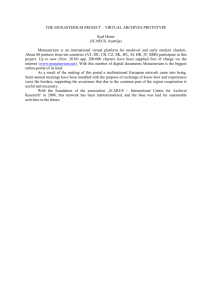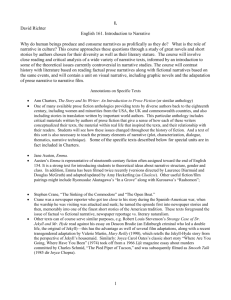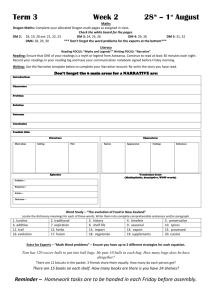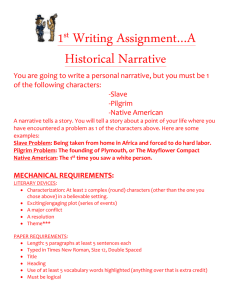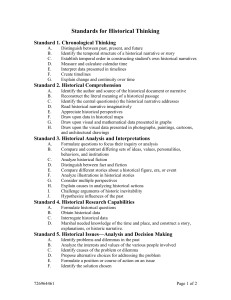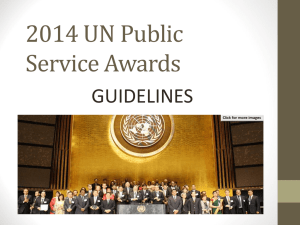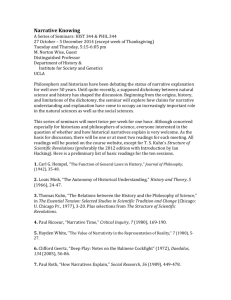Sample Syllabus
advertisement
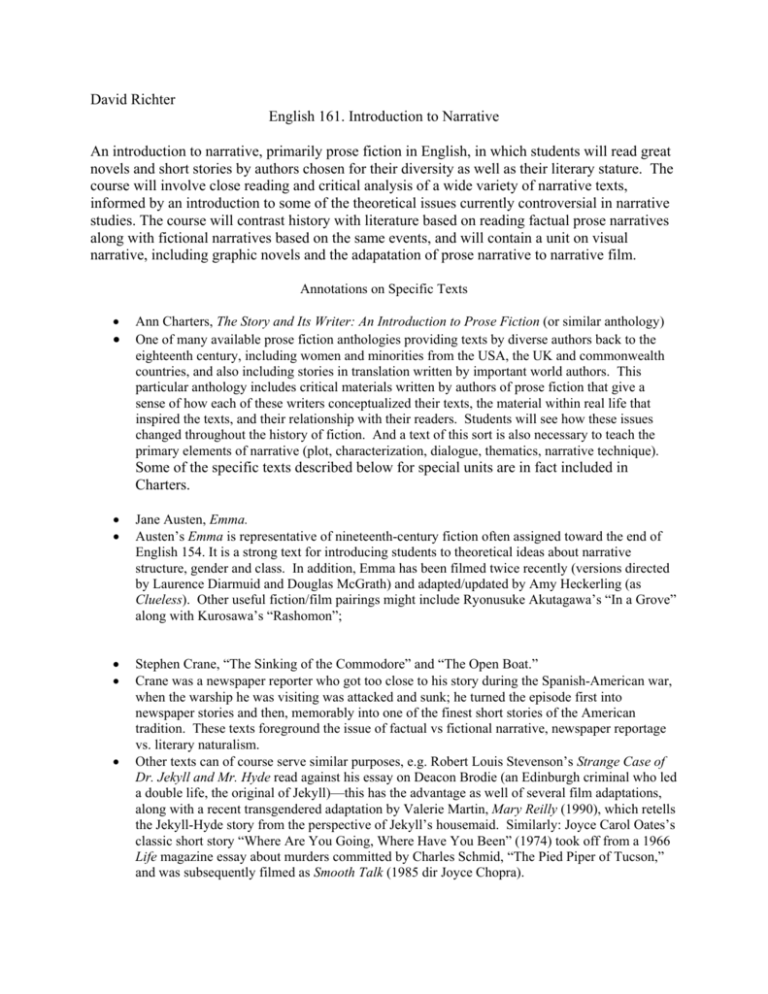
David Richter English 161. Introduction to Narrative An introduction to narrative, primarily prose fiction in English, in which students will read great novels and short stories by authors chosen for their diversity as well as their literary stature. The course will involve close reading and critical analysis of a wide variety of narrative texts, informed by an introduction to some of the theoretical issues currently controversial in narrative studies. The course will contrast history with literature based on reading factual prose narratives along with fictional narratives based on the same events, and will contain a unit on visual narrative, including graphic novels and the adapatation of prose narrative to narrative film. Annotations on Specific Texts • • Ann Charters, The Story and Its Writer: An Introduction to Prose Fiction (or similar anthology) One of many available prose fiction anthologies providing texts by diverse authors back to the eighteenth century, including women and minorities from the USA, the UK and commonwealth countries, and also including stories in translation written by important world authors. This particular anthology includes critical materials written by authors of prose fiction that give a sense of how each of these writers conceptualized their texts, the material within real life that inspired the texts, and their relationship with their readers. Students will see how these issues changed throughout the history of fiction. And a text of this sort is also necessary to teach the primary elements of narrative (plot, characterization, dialogue, thematics, narrative technique). Some of the specific texts described below for special units are in fact included in Charters. • • Jane Austen, Emma. Austen’s Emma is representative of nineteenth-century fiction often assigned toward the end of English 154. It is a strong text for introducing students to theoretical ideas about narrative structure, gender and class. In addition, Emma has been filmed twice recently (versions directed by Laurence Diarmuid and Douglas McGrath) and adapted/updated by Amy Heckerling (as Clueless). Other useful fiction/film pairings might include Ryonusuke Akutagawa’s “In a Grove” along with Kurosawa’s “Rashomon”; • • Stephen Crane, “The Sinking of the Commodore” and “The Open Boat.” Crane was a newspaper reporter who got too close to his story during the Spanish-American war, when the warship he was visiting was attacked and sunk; he turned the episode first into newspaper stories and then, memorably into one of the finest short stories of the American tradition. These texts foreground the issue of factual vs fictional narrative, newspaper reportage vs. literary naturalism. Other texts can of course serve similar purposes, e.g. Robert Louis Stevenson’s Strange Case of Dr. Jekyll and Mr. Hyde read against his essay on Deacon Brodie (an Edinburgh criminal who led a double life, the original of Jekyll)—this has the advantage as well of several film adaptations, along with a recent transgendered adaptation by Valerie Martin, Mary Reilly (1990), which retells the Jekyll-Hyde story from the perspective of Jekyll’s housemaid. Similarly: Joyce Carol Oates’s classic short story “Where Are You Going, Where Have You Been” (1974) took off from a 1966 Life magazine essay about murders committed by Charles Schmid, “The Pied Piper of Tucson,” and was subsequently filmed as Smooth Talk (1985 dir Joyce Chopra). • Syllabus Week I: Introduction to the course. Readings: Katherine Ann Porter: Magic (handout) Introduction to Narrative: Primary Concepts: Authors, Audiences, Narrators. Week II: Plot. Readings: R.S. Crane: The Concept of Plot and the Plot of Tom Jones (BlackBoard Coursepack); Guy de Maupassant: The Necklace (Charters); F. Scott Fitzgerald: Babylon Revisited (Charters); Edith Wharton: Roman Fever (Charters). Week III: Character. Readings: James Phelan: Functions of Character (BlackBoard Coursepack); Anton Chekhov: The Lady with the Pet Dog (Charters) James Joyce: The Dead (Charters). Week IV: Point of View. Readings: Wayne Booth: Distance and Point of View (BlackBoard Coursepack); Isaac Bashevis Singer: Gimpel the Fool (Charters); D.H. Lawrence: The Rocking Horse Winner (Charters); Hawthorne: My Kinsman, Major Molineux (Charters). Week V: Voice and Focalization. Readings: Mieke Bal: Focalization (BlackBoard Coursepack); Seymour Chatman: Voice (BlackBoard Coursepack); James Joyce: Araby (Charters); William Faulkner: That Evening Sun (Charters); Katherine Mansfield: The Garden Party (Charters) . Week VI: Time and Pacing. Readings: Gérard Genette: Order, Duration, Frequency (BlackBoard Coursepack); Frank O'Connor: Guests of the Nation (Charters). John Cheever: The Swimmer (Charters) Week VII: The Language of Fiction. Readings: Dorrit Cohn: Narrated Monologue (BlackBoard Coursepack); Imaginative Readings to be announced. Week VIII: The Reader in the Tale. Readings: Gerald Prince: Introduction to the Study of the Narratee (BlackBoard Coursepack); Peter Rabinowitz: Truth in Fiction: A Re-examination of Audiences (BlackBoard Coursepack); Peter Brooks: Narrative Desire (BlackBoard Coursepack). Imaginative readings to be announced. Week IX: Fiction and Gender: Readings: Susan Sniader Lanser Toward a Feminist Poetics of Narrative Voice (BlackBoard Coursepack); Rachel Blau DuPlessis: Breaking the Sentence, Breaking the Sequence (BlackBoard Coursepack); Eve Kosofsky Sedgwick: Introduction to The Epistemology of the Closet (BlackBoard Coursepack); Anton Chekhov: The Darling (Charters); Charlotte Perkins Gilman: The Yellow Wallpaper (Charters); Joyce Carol Oates: Where Are You Going, Where Have You Been? (Charters) Willa Cather: Paul's Case (Charters) Week X: Fiction and Class: Social approaches to narrative: Readings: Karl Marx: from The German Ideology (BlackBoard Coursepack); Fredric Jameson: The Realist Floor Plan (BlackBoard Coursepack); Gustave Flaubert: A Simple Heart (Charters) John Updike: A & P (Charters). Week XI: Fiction and Race/Ethnicity: Readings: Ralph Ellison: Hidden Name and Complex Fate (BlackBoard Coursepack) Henry Louis Gates, Jr.: Introduction to The Signifying Monkey (BlackBoard Coursepack) James Baldwin: Sonny's Blues (Charters); Kate Chopin: Désirée's Baby (Charters) Sherman Alexie: The Lone Ranger and Tonto Fight in Heaven (Charters) Week XII: Factual/Fictional Narrative Readings: Don Moser: “The Pied Piper of Tucson Joyce Carol Oates: “Where Are You Going, Where Have You Been” Stephen Crane: “The Sinking of the Commodore” Stephen Crane: “The Open Boat” Week XIII: Narration within Graphic Novels Reading: Maus Week XIV: Fiction into Film Jane Austen: Emma Amy Heckerling: Clueless The course will include three papers, an essay final exam, and attention to writing issues in class, according to the Writing Intensive criteria. II. Carrie Hintz English 161. Introduction to Narrative: Life Writing How do writers use narrative to construct their life stories and the lives of others? What role does the writing of stories of individual lives play in culture generally, and what contribution does the study of such writing make to the liberal arts? This course will explore the distinctive, intensive, and compelling way in which life writing brings us inside the experience and perspectives of other people. It also explores the narrative nature of life writing, with attention to point of view, tone and narrative structure, as well as to the cultural implications of life writing. Throughout the course, we will try to define the main genres of life writing (biography, autobiography, letters and diaries)—with the awareness that the distinction between these forms is anything but clear. Much of the course will be devoted to experiments in life writing forms (from the modernist period forward) and the link between novels and life writing. Secondary readings will include writings by Samuel Johnson, James Olney, Georges Gusdorf, Peggy Kamuf, Carolyn Heilbrun, Sidonie Smith and Julia Watson, Carl Rollyson, and Paul John Eakin. Truth and Fabrication: Autobiography, Letters, Diaries and the Fictive Weeks One & Two: James Frey, A Million Little Pieces (2003); newspaper and magazine articles from the Frey controversy (and TV interviews and reports) Thomas De Quincey, Confessions of an English Opium Eater (1821) Week Three: Virginia Woolf, Moments of Being (published in 1972) Week Four: Audre Lorde, Zami: A New Spelling of my Name: A Biomythography (1982) Week Five: Selected letters and diary excerpts (to be announced) Post Secret website and books: http://postsecret.blogspot.com/ Reading Biography Week Six: John Aubrey, excerpts from Brief Lives (late seventeenth century; first published in 1898); Samuel Johnson, Life of Savage (1745); Rambler 60 (1750) Week Seven: William Godwin, Memoirs of the Author of a Vindication of Woman (1798) Week Eight: Excerpts from Cardinal Newman, Apologia pro vita sua (1865); Lytton Strachey, Eminent Victorians (1918) Relational auto/biography & experiments in form Week Nine: Mark Doty, Heaven’s Coast (1997) Joan Didion, The Year of Magical Thinking (1996) Week Ten: Art Spiegelman:, Maus (1991) [CD-Rom version will also be made available] Week Eleven: Gertrude Stein, The Autobiography of Alice B. Toklas (1932) Week Twelve: Theresa Hak Kyung Cha, Dictee (1982) Life Writing and the Novel Week Thirteen: Sylvia Plath, The Bell Jar (1963) Week Fourteen: M. T. Anderson, The Astonishing Life of Octavian Nothing, Traitor to the Nation (2007) Writing will include three papers, an essay exam, and attention to writing issues in class discussion, according to the Writing Intensive requirements. III. Veronica Schanoes English 161. Introduction to Narrative: Fairy Tale and Myth Myth and fairy tale are two of the abiding and influential forms of narrative. What is myth? What is a fairy tale? What functions do they serve? How are they shaped by larger cultural forces and what are their effects on that culture? In this class, we approach these questions by taking a fresh, in-depth look at some of the familiar fairy tales and myths that have continued to haunt us. By reading different versions of these tales, collected at different times and in different places, we will gain an understanding of the way that stories express the social concerns of their context as well as the individual concerns of the author, editor, or collector, of how, that is, the process of transmission and revision adapts the same story to different perspectives. We will then study and discuss the way that these tales continue to influence and appear in contemporary culture: how have they been changed and why return to them at all? In dealing with these issues, we will be asking why, in a modern age that stresses rational and scientific thinking, myths and fairy tales continue to appeal to writers and readers (and filmgoers) and how they still help us define our experience and our wishes and anxieties. We will be studying the interaction between “popular” and "sophisticated” forms of culture. In all these ways, we will be showing why a study of myth and fairy tale adds an important dimension to our general education in the liberal arts. In this class, we will examine the process and significance of storytelling by examining two of the fairy tales and two of the classical myths that have shaped our culture. In each unit of about three weeks, the class will read several different versions of the given tale, and then two or three examples of criticism explaining the way the tale has functioned. Each unit will end with a look at modern revisions of the tale and a consideration of how—and why—it has been changed. Unit one: Cinderella Primary Texts - “Yeh-hsien” (the earliest version of Cinderella, from a 10th-century Chinese manuscript) “Cat Cinderella” – Giambattista Basile “Cinderella” – Charles Perrault “Ashenputtle” – Brothers Grimm “Rushen Coatie” – Scottish tale Cinderella – Disney movie Criticism - Excerpt from Breaking the Magic Spell – Jack Zipes “America’s Cinderela” – Jane Yolen Revisions - “Ashputtle” – Angela Carter “Ashputtle’ – Peter Straub “Cinderella” – Anne Sexton Unit two: Bluebeard Primary Texts - “Bluebeard” – Perrault “Fitcher’s Bird” – Brothers Grimm “Mr. Fox” – Joseph Jacobs “The White Dove” – Gaston Maugard Criticism - excerpt from Secrets Beyond the Door – Maria Tatar “When We Dead Awaken: Women’s Writing as Re-Vision” – Adrienne Rich “Notes from the Front Line” – Angela Carter Revisions - “The Bloody Chamber” – Angela Carter “Untitled Bluebeard Sonnet” – Edna St. Vincent Millay The Piano – dir. Jane Campion Unit three: Persephone and Demeter Primary Texts - The Homeric Hymn to Demeter – trans. Helene P. Foley Excerpt from Metamorphoses, bk. 5 – Ovid “Variants of the Myth” – Helene P. Foley Criticism - excerpt from “Interpretive Essay on the Homeric Hymn to Demeter” – Helene P. Foley excerpt from Of Woman Born – Adrienne Rich “Family Structure and Feminine Personality” – Nancy Chodorow Revisions - excerpts from Mother Love – Rita Dove “Demeter” – H. D. “Demeter” – Carol Anne Duffy “The Pomegranate” – Eavon Boland Unit four: Odysseus Primary Texts - excerpts from The Odyssey excerpts from The Greek Myths – Robert Graves Criticism - excerpts from The Hero’s Journey – Joseph Campbell Revisions - excerpt from Ulysses – James Joyce “Ulysses” – Alfred, Lord Tennyson “Circe/Mud Poems” – Margaret Atwood excerpts from The Penelopiad – Margaret Atwood Odyssey – Mary Zimmerman The course includes three papers, an essay exam, and attention to writing issues in class, according to the Writing Intensive criteria.
